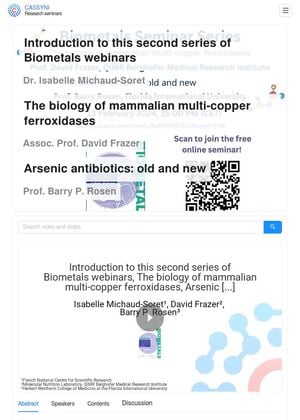Introduction to the Second Series of Biometals Webinars: The Biology of Mammalian Multi-Copper Ferroxidases and Arsenic Antibiotics
February 2024

TLDR Some bacteria use arsenic compounds as antibiotics, and others have evolved resistance; a particular arsenic-based compound shows potential as a new antimalarial treatment.
The document discusses the role of arsenic in microbial warfare, where some bacteria use organoarsenicals as weapons against other bacteria. Early organisms evolved genes/proteins for resistance pathways that transport and biotransform arsenic, with nearly 30 genes with demonstrated functions identified in arsenic operons. One example is the arsM gene, which catalyzes the methylation of inorganic arsenic to form highly toxic methylarsenite (MAs(III)), a substance with antibiotic properties. Other microbes evolved genes/proteins to transform methylarsenicals into less toxic forms, demonstrating antibiotic resistance. The document also highlights the synthesis of arsinothricin (AST) by the soil bacterium Burkholderia gladioli GSRB05, a nonproteogenic amino acid with broad-spectrum antibiotic action effective against dangerous human pathogens and Plasmodium erythrocytic proliferation and parasite transmission to mosquitoes. The document suggests that AST could be a promising lead compound for developing a new class of multi-stage antimalarials.